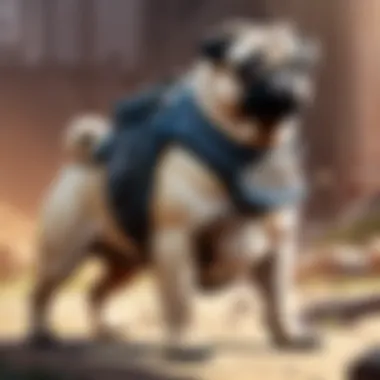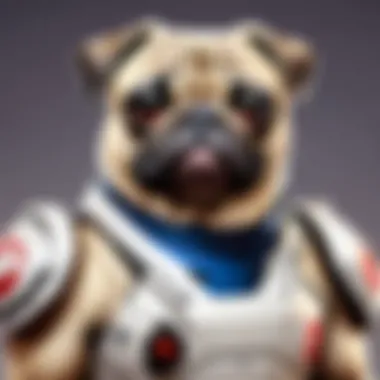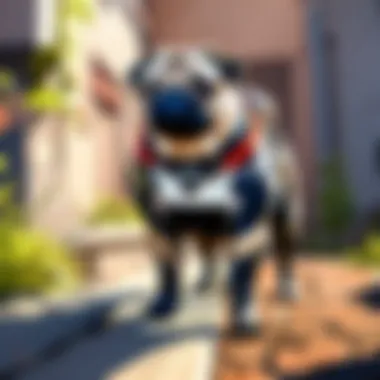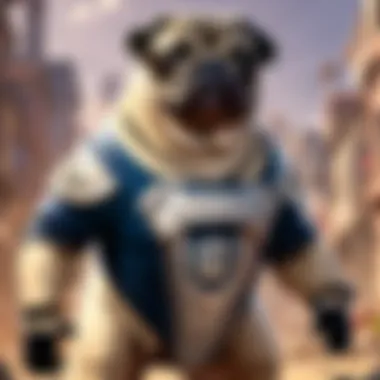Understanding the Meaning of 'Pug' in Gaming Culture


Intro
In recent times, the term 'pug' has gained prominence in the gaming circles, especially among players of tactical shooter games like Valorant. Its origin, meaning, and consequences stretch across the competitive gaming landscape and inform the manner in which players communicate and strategize. In this exploration, we aim to unpack the concept of 'pug' by considering its evolution within online culture and its specific implications within the Valorant community.
Game Overview
Foreword to Valorant
Valorant is a tactical first-person shooter developed by Riot Games, known for its emphasis on strategic gameplay and teamwork. Released in June 2020, it quickly garnered a significant following. Players can experience intense games that demand not only superior aim but also coordination with teammates. The game artfully combines unique characters or agents, each with their own abilities, into match formats that uphold traditional shooter elements with modern twists.
Game Mechanics and Objectives
In Valorant, matches typically pit two teams of five players against one another. The primary mode involves one team attacking while the opposing team defends, tasked with planting or defusing a device known as the Spike. Players strive to win rounds through skillful execution, meticulous resource management, and thoughtful tactical strategies.
- Core Elements: Players must communicate effectively, secure wins through strategy, and capitalize on strengths—both personal and from their designated agents.
- Game Flow: Valorant rewards not just aim but also thinking ahead, encouraging players to adapt as they learn opponents’ tendencies.
Brief History of the Game
Valorant was in closed beta for several months prior to its official release, which allowed many players to test its mechanics and provide feedback. Early adopters noted the balance of characters and game modes quickly became a benchmark in shooter game quality. Riot’s previous experience with other esports titles, particularly League of Legends, guided them in creating this engaging community-centric game.
Subsection: List of Playable Agents and Their Unique Abilities
Valorant features a diverse cast of agents who possess individual skills that can be pivotal in game contexts. Some examples include:
- Phoenix: Heals himself through fire-based abilities.
- Cypher: Utilizes security cameras and traps to gather intelligence on opponents.
- Sova: Compliles owl drones and arrows to scout out enemy combatants.
Defining 'Pug'
Defining the term 'pug' is crucial for understanding its significance in gaming culture, particularly within tactical shooter environments like Valorant. Understanding 'pug' provides insights into casual and competitive play, shaping how players interact and refine their skills. Players join these informal matches primarily to enhance their gameplay, sharpen their strategies, and engage with fellow gamers in a low-pressure setting.
General Definition
The term 'pug' in the gaming world generally refers to a casual match where players are grouped together without the pressures of formal competition. This facilitates a relaxed environment, allowing players to experiment with their techniques and roles. It is significant as it opens the door for both newcomers and more experienced players to practice together, bridging the gap between different skill levels.
Key Characteristics of Pugs:
- Informality: Pugs occur without stringent regulations, focusing more on enjoyment and practice than on winning.
- Dynamic Teams: Players may join various matches with different players each time, avoiding fixed team compositions.
- Skill Exploration: Participants can try various roles or characters they may not use in more serious contexts, enriching their overall gameplay.
Specific Context in Gaming
In the gaming landscape, particularly in first-person shooters and online multiplayer games, the context of 'pug' refers to matches that are not officially organized or categorized as competitive play. In arenas like Valorant, players enter pug matches to practice strategies and mechanics without the fear of consequences commonly associated with ranked matches.
In competitive gaming, versatile play is valuable. Engaging in pugs can help players adjust quickly to a range of scenarios.
Reasons for Pug Matches in Gaming:
- Experimentation: Players can try new strategies or characters without major penalties.
- Team Building: Pugs encourage community collaboration, as players need to work cohesively despite varying backgrounds.
- Pressure-Free Environment: The relaxed structure allows players, especially beginners, to enjoy the gaming experience while still gaining valuable knowledge.


In summary, defining 'pug' reveals its utility in enhancing gameplay experiences, facilitating community engagement, and fostering individual skill development. Through such matches, gamers of all levels can collaboratively advance while navigating the fundamental aspects of teamwork and strategy.
Etymology of 'Pug'
The etymology of the term 'pug' plays a foundational role in comprehending its usage within gaming culture. Understanding its origins provides insight into how it evolved into a term that resonates within various communities and forms. Words are not just labels; they carry meaning and context. This exploration illuminates how 'pug' traversed linguistic landscapes and morphed in meaning, ultimately finding its way into competitive gaming environments.
Origins of the Term
The word 'pug' has uneven roots. Originally, 'pug' referred to a breed of dog, characterized by its small size and wrinkled face. This connection to a form may be surprising when considered in the grooming world of esports. Two areas research important are folk etymology and modern adaptations that resonate with the unique culture among players. Additionally, other theories suggest that it derives from a slang term associated with boxing or fighting. Overall, this ambiguity gives a starting point to examining its evolution in gaming contexts.
Evolution of Meaning
With a speed matched only by internet culture's mercurial nature, 'pug' transformed into a beacon term in gaming. Traditionally, it appeared related to casual play sessions among friends or gaming acquaintances, where the match is informal and unstructured. Inline gaming communities, it signifies the occurrence of spontaneous gatherings, encouraging participation without heavy competition norms.
This flexibility in understanding shows its relevance. Players engage in pugs to hone skills without the pressures of organized forays. Initially widespread in games like Counter-Strike, 'pug' became essential for testing strategies and learning in a more relaxed setting.
Over time, the implications broadened further with titles like Valorant. Pugs maintain a life of their own, distinct from structured game formats. They remain inherent in the gaming culture, aiding players something serious and yet fun. Even in a highly competitive domain, the core aspect of puggin conveys a form of brotherhood among players.
The Role of 'Pug' in Competitive Gaming
Pug matches serve a significant role in the competitive gaming landscape. They provide players an informal yet valuable environment to hone their skills and test team synergies. The term 'pug' is rooted in the concept of quick and casual matches, where players join together without the formal setup typically present in traditional esports fixtures.
In a pug, gaming is less about structured gameplay and more focused on individual skill and cooperation between participants. Such matches serve as a versatile platform for experience acquisition, appealing to both casual gamers and serious competitors. It allows players to engage with others, experiment with strategies, and experience real-time adjustments amid various gameplay obstacles.
Over time, the pug concept has gained traction in many games like Valorant. This kind of setup promotes collaboration but also necessitates a solid grasp of teamwork fundamentals. Players entering a pug can thus familiarize themselves with various character roles while improving their communication and tactical interactions in high-pressure situations.
Moreover, bolstering the ecosystem of competitive gaming, pug matches break down hierarchical barriers that sometimes arise in more formal gaming settings. Newer players can compete alongside veterans, learning nuances of gameplay through practice, thereby cultivating a deeper appreciation for game mechanics and strategies.
Instead of following rigid rules, pugs embrace spontaneity. This can lead to unpredictability in each match. Players quickly adapt and respond to this incessant shift, sharpening their reflexes and decision-making capacities.
Pug matches cultivate a space where learning and player growth converge. They are vital for forming social bonds within the gaming community, reinforcing collective problem-solving capabilities in various scenarios.
In light of these factors, engaging in pug matches not only incorporates fun but significantly contributes to the players' evolution over time. The informal discourse around tactics and future strategies spurred in such environments often translates to competitive advantages in more formal play.
Pugs in Valorant
In the realm of competitive gaming, particularly within Valorant, the concept of 'pug' carries immense significance. Pugs enhance the gaming experience and functionality of the online community. Essentially, these matches are more casual than scrimmages yet still facilitate practice and competition among players. Pugs serve as a critical way for players to engage with one another in a less serious setting, allowing individual and team skills to develop organically.
How Pugs Fit into Valorant's Ecosystem
Pugs play a crucial rol in Valorant’s ecosystem. They provide a bridge between casual play and structured tournament eformation. Pug matches allow players to assemble teams, test different strategies, and assess personal performance without the pressures of a formal environment. Unike more official formats where strategies may be strictly scripted, pugs often incure more adaptability.
In addition, pug matches are organized through different platforms like Discord and Reddit, creating vocal comunities exchange ideas and comprehensive player feedback. This interaction is invaluable for shaping the nature of play and developing a competitive mindset among the younger players. Overall, pugs represent a flexible training ground for adept players aiming to refine their skills while also remaining socially rooted within their gaming circles.
Community Perception of Pug Matches
The community’s view of pug matches in Valorant can vary greatly. For casual players, these matches offer a welcoming environment that reduces torment and promotes learning. Some view pugs as a real-life simulation of what plays out during high-stakes competitions. On the utther hand, competitive or top-tier players may view pugs differently; they might see them as chaotic because of non-optimized team compositions and the wide skill variances among participants.


However, this diversity in skill level can create an engageing learning opportunity. Specific areas of gameplay are often pushed to new limits. Players can learn new tactics in fights, discover their preferred agent's abilities, and adapt to unfamiliar roles within these pug matches. Participation often promotes growth through exposure to similarly charged but informally competitive scenarios.
Ultimately, the allure of pugs lies in their ability to create a diverse and inclusive narrative within the game’s player community. They serve as vibrant forums where expanding relationships and recognizing core mechanics of the gameplay is valued over achieving victory above all else.
Advantages of Participating in Pug Matches
Participating in pug matches offers a unique range of benefits for players. This informal gameplay format encourages innovation and creativity, as everyone actively collaborates in a less rigid environment. Pugs create space for players to experience real-time scenarios similar to competitive matches with less pressure. It’s this low-stakes atmosphere that often reveals to both casual gamers and serious competitors where they excel and what areas need more improvement.
Skill Development Opportunities
One primary advantage of engaging in pug matches is the significant opportunity for skill development. In these matches, players can hone individual abilities as well as team coordination skills. Such mastery is valuable, particularly in competitive settings. According to many players’ experiences, the more varied the opponents in a pug, the better one becomes in quickly adapting strategies and enhancing game knowledge.
Skill sets acquired from pug matches can be classified as follows:
- Mechanics Improvement: Practicing fundamental skills such as aiming, movement, and ability usage can lead to enhanced performance. Having diverse opponents challenges players and fosters improvement in different skill aspects.
- Strategic Thinking: Engaging with multiple teammates who have their own styles and thought processes cultivates new tactical ideas. One learns to result the varying views during play, creating a versatile adventure in realizing best tactics.
- Feedback Mechanism: Being part of a changing group of players allows access to instant feedback. Constructive criticism post-game elevates overall gameplay. Observing different playstyles can also lead to insights on existing weaknesses.
Networking with Other Players
A secondary, yet equally significant aspect of participating in pug matches encompasses the possibility of networking with other gamers. Many players meet friends; some even form lasting teams. Here’s how embracing this networking opportunity can be beneficial:
- Broader Connections: Players across this wide environment share experiences and recommendations that could be mutually beneficial. Team up with participants one may not otherwise interact with. Gathering varying perspectives promotes growth.
- Building Chemistry: By consistently playing with the same group, individuals begin developing rapport. This connection often extends to longer-term partnerships in official competitions or other esports endeavors.
- Opportunities for Advancement: Sometimes contacts made during pugs can lead to larger roles in other teams or groups. Introducing successful and skilled players to familiar networks may increase visibility in select communities.
Fór example, many competitive players cite initial partnerships formed during pugs leading to top-tier teams.
Engaging in pug matches therefore serves resepctable purposes beyond mere play. The mixture of skill enhancement and opportunities for networking creates a vital experience for individuals in gaming. Through careful visualization of triumph areas and use of contacts made during play, players find routes to explore their full potential in the expansive world of esports.
Challenges Associated with Pugs
In the complex environment of competitive gaming, participating in pug matches can present various challenges. Understanding these difficulties is vital, as they significantly impact both gameplay experience and performance. Recognizing the common issues can prepare players better and assure a more rewarding approach in pug matches.
Tactical Disarray and Communication Issues
One of the most prevalent challenges in pug matches is the potential for tactical disarray. Players often join these games without any prior coordination or established strategies. This spontaneous nature can lead to conflicts over decision-making and execution. When players have different expectations for roles, gameplay styles, and objectives, it becomes hard to operate cohesively.
Communication is the bedrock of effective teamwork. During pug matches, players often use voice chat for real-time conversation, yet they might face barriers like varied accents, jargon, or simply differing communication preferences. Misunderstandings can frequently arise, resulting in poor execution of plans or missed opportunities.
An effective communication system based on clarity and mutual understanding is essential. This requires both verbal and non-verbal cues to align team members during gameplay. Establishing clear roles and strategies at the onset can help counteract the tactical disarray that complicates pug matches.
Communication is key. Failing to articulate strategies saboages the collective team effort.
Dealing with Varying Skill Levels
Another considerable challenge is the varied skill levels among participants. Pug matches typically involve players with differing degrees of expertise. While this diversity can provide learning opportunities, it can also create frustration. Higher-skilled players may find themselves hindered by those less experienced. In contrast, less seasoned players may struggle to keep pace with the game's demands.
To navigate these disparities, it is necessary for players to practice patience and adaptation. Creating an encouraging environment is crucial, particularly for newer entrants. Experienced players can offer guidance and mentoring, smoothing over difficulties and enhancing collective performance.
Combining skill levels impels continuous learning. Even asgaining expertise, players benefit from learning how to support diverse teammates effectively, thereby enriching their own gameplay experience in this dynamic environment.


Being aware of these challenges aids in faring better in puppy matches, fostering an atmosphere of growth, adaptation, and communication.
Strategies for Successful Pug Participation
Participating in pug matches can be both rewarding and challenging for players eager to improve or simply enjoy a relaxed game experience. Effective strategies are imperative for maximizing the benefits while minimizing frustrations. Understanding these tactics is crucial for both casual gamers and more competitive players.
Effective Communication Techniques
Communication is a vital component in any team setting, specifically in pug experiences where synergy often dictates success. Effective communication techniques focus on clarity and timeliness, allowing players to convey essential game information without misunderstandings. Here are some important practices to focus on:
- Use Voice Chat Purposefully: Engage with your team consistently. Strategies or enemy positions must be shared as quickly as possible. Saying "Watch out! two enemies B site!" is often far more effective than merely tagging players in-game.
- Contextual Brevity: Pugs often feature various players who might not all be familiar with each other’s styles. Tasks should be assigned in a short, clear manner. Instead of a lengthy explanation, state something like “I’ll cling to mid. You guys advance.” This helps to maintain a smooth information flow.
- Encourage Feedback: Players should never hesitate to ask clarifying questions or provide constructive feedback. An approach such as, "Did you need me to cover that spot?" promotes a more open team environment and ensures no roles are mismatched during crucial moments.
Adapting to Team Dynamics
No two pug matches are alike; effects of team compositions, personalities, and individual skill vary significantly. Adaptability can often dictate an individual player’s comfort and effectiveness. Understanding and managing team dynamics include a few key propositions:
- Recognize Skill Levels: Every pug possesses players with different capabilities. Adapting to this variation is crucial. Knowing when to take the lead or simply play defensively is part of the process. Lead by example when playing with lesser-experienced teammates or learning from those with advanced sets as either can advance the group’s overall proficiency.
- Balance Roles and Masteries: Determining roles based on team composition ensures effectiveness and harmony. A well-def roted strategy involves clearly displaying who should handle offensive or defensive positions. it's impactful to discuss and agree on this at the start of the match,I means having a conversation about.Assertions regarding who’s playing ‘dualist’ versus ‘controller’ roles avoids late-game adjustment bumps.
- Emotional Intelligence Matters: Being aware of team morale is fundamental. Pugs are informal and enjoyable but pressure can quickly alter a sensation. Be empathetic. If someone erupts in anger after a bad play, choose to respond positively rather than retaliating. Saying, "Everyone has bad games, let's reset,” helps to cultivate a more supportive atmosphere.
Effective participation in pug matches requires agile communication and the capacity to adapt. Harmonizing these aspects amplifies the chances of a fulfilling gaming experience.
Understanding these strategies transcends merely winning matches in pugs; it cultivates valuable skills group dynamics, providing foundational elements that can grow one’s gaming instinct. Every play, every round contributes to both personal and community growth, echoing the essence of camaraderie present in the greater gaming landscape.
The Future of Pug Culture in Esports
The evolution of pug culture in esports is not merely an academic interest; it carries profound implications for community interactions, player development, and the overall dynamics of competitive gaming. As competitive environments continue to expand, understanding the trajectory of pugs can offer insights into future developments and best practices. This section explores critical elements regarding how this culture may change. It dives into unique benefits while considering potential challenges that could arise.
Potential Changes in Community Interaction
The structure of gaming communities may transform significantly due to rising interest in pug gameplay. Players' social interactions often influence their gaming experience and long-term engagement with the community. As pugs gain popularity, the community might foster stronger ties through more regular organized matches. Regular feedback loops can empower players to learn from shared experiences.
There might be a shift in mindset among players. Collaborative improvement becomes the focus rather than solely individual performance. Players may develop relationships that transcend game matches, promoting a culture of support and understanding. Moreover, community-driven platforms can emerge. These channels would streamline arranging pugs, enhancing organization and communication.
In summary, community interaction can shift toward a more collaborative and supportive ecosystem, motivated by shared goals and values.
Impact of Technological Advancements
Technological innovations play a crucial role in shaping pug culture's future in esports. Improvements in connectivity and matchmaking algorithms are crucial as they enhance player experience. Tools such as voice communication and performance analysis software could streamline team collaboration.
Here are some technological aspects that are likely to impact future pug environments:
- Matchmaking Systems: AI and machine learning can revolutionize how players are matched, prioritizing not just skill levels but also playstyles and team balance.
- Game Features: Enhanced in-game tools might allow players to easily communicate strategies or tactics during pugs, thus encouraging better teamwork.
- Analyzing Performance: Advancement in analytics may facilitate performance evaluations. Tools that record gameplay statistics could assist players in identifying strengths and weaknesses.
These advancements create an environment that focuses on development rather than isolation. The future may prompt interactions and community dynamics that embrace both competition and camaraderie.
The inclination toward using technology effectively might catalyze collaboration among players, fostering an enriched gaming atmosphere.
As technology continues to advance, the impact on pugs will play a pivotal role in defined relationships. Continued research and adaptation will be essential for community members to maximize benefits offered. The path forward in pug culture seems promising and includes untapped potentials for collective growth in the esports arena.
Ending
Through our exploration, we highlighted several aspects of 'pug' culture, such as its etymological background, the structure of pug matches, and how they differ from scrimmages. Importantly, we addressed the advantages that players gain through participation, namely skill development and community engagement. However, potential challenges are also present, like tactical disarray and communication fluctuations that players must navigate.
Considering the future, advancements in technology may shape how 'pug' matches are organized and played. Consequently, staying informed about these changes is imperative for both casual gamers and competitive players alike.
Understanding 'pug' culture is integral to grasping the broader context of esports and gaming communities. As our journey through this topic demonstrates, the implications of the term and its functions comprise a complex interplay essential for every player's success and enjoyment in the ever-evolving landscape of online competition.



